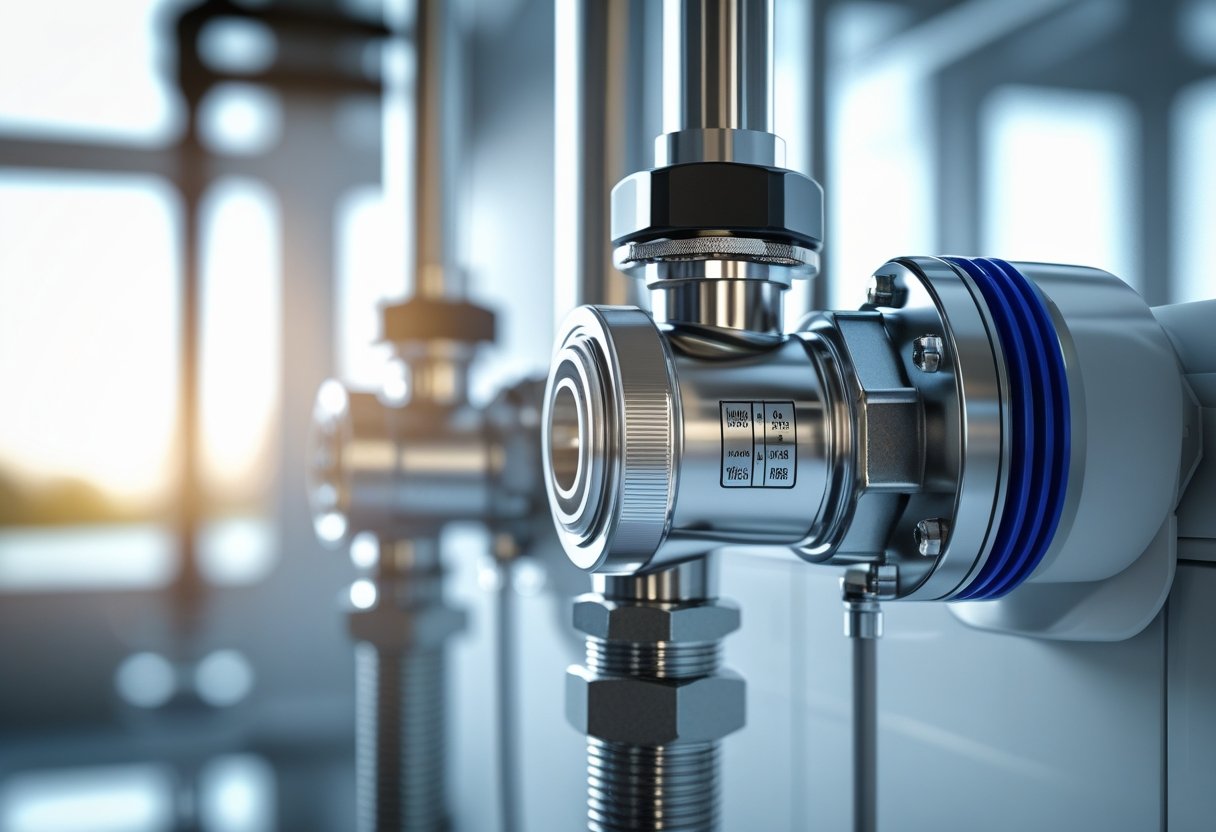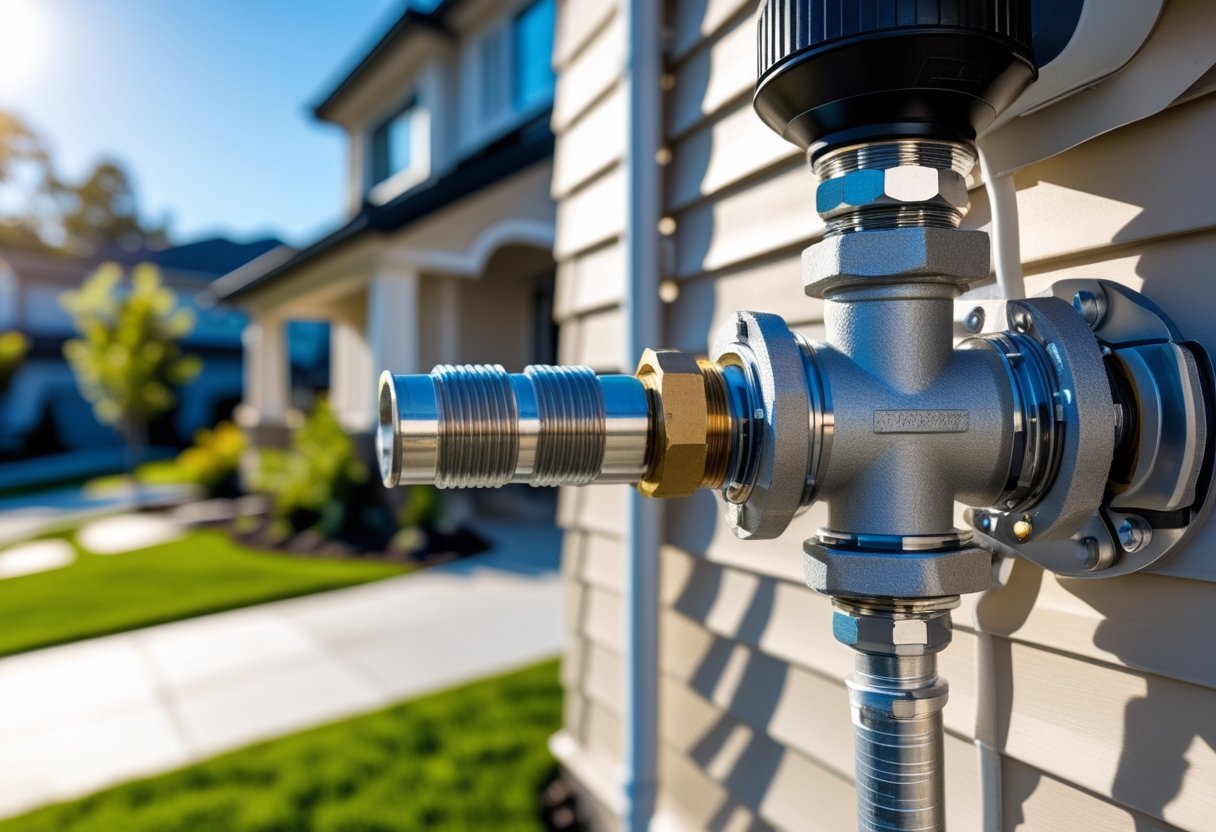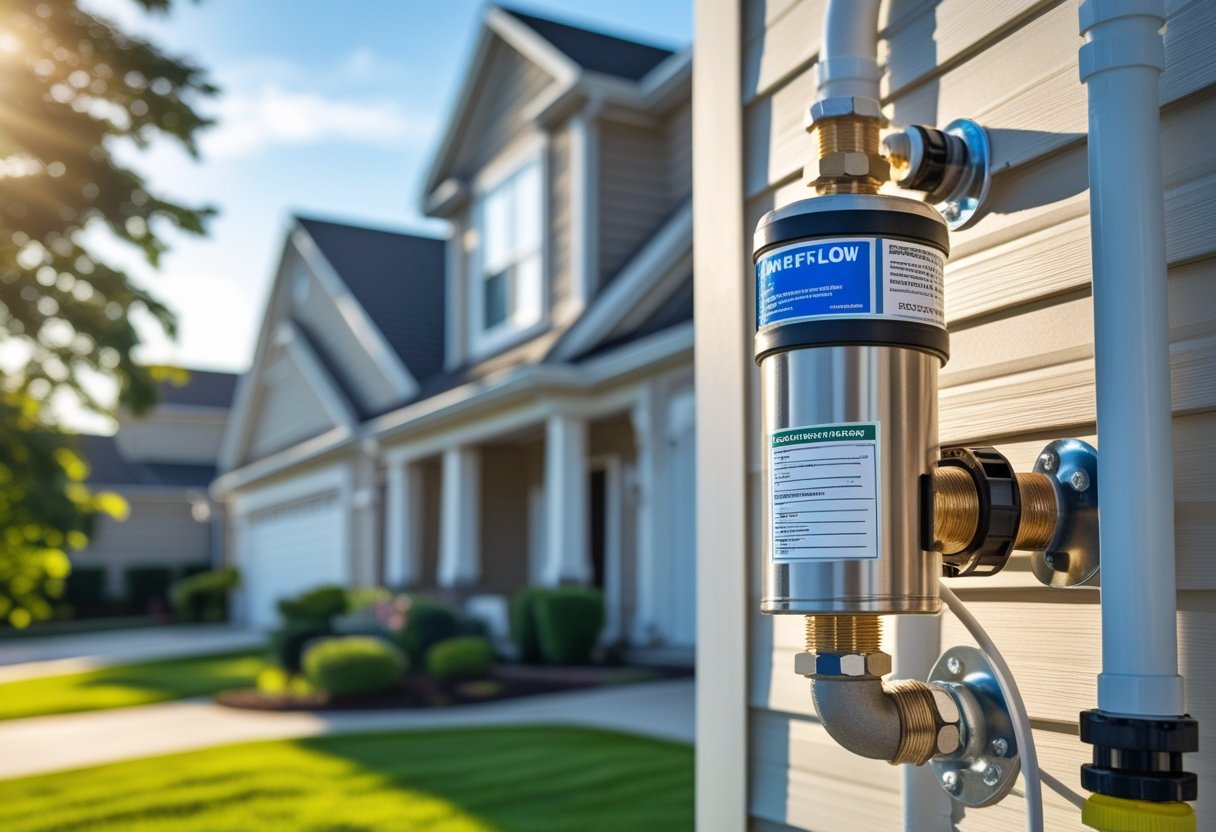Most commercial property owners don't realize that backflow testing is a legal requirement that could result in serious fines if ignored. Backflow testing for commercial properties is mandatory across the United States, with local regulations requiring regular inspections to protect public water supplies from contamination. Without proper testing, businesses face significant penalties and put their customers and employees at risk.
We've seen countless business owners discover they're out of compliance only when it's too late. The consequences go beyond just fines - contaminated water systems can damage your reputation and create liability issues that affect your bottom line.
We'll walk you through everything you need to know about commercial backflow testing, from California's specific regulations to who handles the actual testing process and what you can expect to pay.
Here’s what you need to know:
- What commercial backflow testing actually involves
- California backflow testing requirements for commercial systems
- Who's responsible for testing: Owners, tenants, or managers?
- How much commercial backflow testing usually costs
- Why Pacific Backflow is the preferred provider for San Diego businesses
Keep reading! Understanding your specific testing requirements, costs, and responsibilities as a property owner or manager is crucial for staying compliant.
What commercial backflow testing actually involves
Commercial backflow testing examines specific devices that prevent contaminated water from entering your building's clean water supply. The process differs significantly from residential testing due to larger systems and stricter regulations.
How the test protects your building's water from contamination
Backflow prevention devices act as barriers between your building's plumbing and the public water system. These devices stop dirty water from flowing backward into clean water pipes.
During testing, we check if these protective barriers work properly. A certified technician examines each backflow assembly to ensure it creates the right pressure.
The test involves shutting off water valves and measuring pressure readings. We look for specific pressure drops that prove the device blocks contaminated water.
According to the U.S. EPA’s Revised Total Coliform Rule guidance, backflow is the reverse movement of non-potable water into the potable system through an unprotected cross-connection, caused by reduced pressure in the distribution system (backsiphonage) or increased pressure in the non-potable system (backpressure).
Cross-connections pose the biggest risk to your potable water supply. These connections link clean water pipes to potentially dirty sources like boilers or cooling systems.
Testing finds weak points where contamination could enter. We identify problems before they affect water quality or cause health issues.
The difference between residential and commercial testing
Commercial properties require more complex testing than homes. Business buildings have larger water systems with multiple backflow assemblies.
Commercial plumbing systems often include:
- Industrial equipment connections
- Fire suppression systems
- Cooling towers
- Kitchen equipment
We test each connection point separately. This process takes longer than residential testing because of the system size.
Commercial tests happen more frequently than residential ones. Most areas require annual testing for businesses compared to less frequent home testing.
The testing equipment differs too. We use specialized gauges designed for larger commercial systems and higher water pressures.
What types of backflow devices are found in business properties
Different business types need specific backflow prevention devices based on contamination risk. We perform hazard assessments to determine the right device type.
Reduced Pressure Zone (RPZ) assemblies protect against high contamination risks. These devices work well for:
- Restaurants with grease traps
- Medical facilities
- Chemical processing plants
Double Check Valve assemblies handle lower risk situations like office buildings or retail stores. These devices cost less but provide basic protection.
Pressure Vacuum Breakers prevent backflow in irrigation systems and outdoor equipment. Many businesses use these for landscaping connections.
Air gaps provide the highest protection level. We recommend these for the most dangerous contamination sources like laboratory equipment or industrial processes.
California backflow testing requirements for commercial systems
California requires all commercial properties with backflow prevention devices to complete annual testing by certified professionals. Local water authorities enforce these rules through municipal ordinances to protect public health and drinking water quality.
How often businesses are required to test (and why it varies)
Most commercial properties in California must test backflow devices once per year. This annual requirement applies to nearly all businesses with backflow prevention systems.
The testing schedule rarely varies because California regulations set a standard yearly requirement. We see consistent enforcement across different cities and counties.
Some properties may need more frequent testing if:
- The device protects high-risk facilities like hospitals or food processing plants
- Local water authority rules require additional tests
- Previous test results showed problems
Testing must happen within 12 months of the last test date. Missing this deadline puts your business out of compliance immediately.
According to the U.S. EPA’s Cross-Connection Control Manual, water purveyors should ensure all testable backflow devices are tested by certified personnel at intervals specified in the local ordinance, with test documentation submitted to the state authority.
The annual requirement exists because backflow devices can fail over time. Springs weaken, seals crack, and debris blocks proper function.
Which local agencies enforce testing compliance
Your local water authority handles backflow testing compliance in most California cities. These agencies track testing schedules and issue compliance certificates.
Many cities run their own enforcement programs:
- City water departments
- Public utilities districts
- Municipal water agencies
Each agency maintains records of:
- Which properties need testing
- When tests are due
- Current compliance status
As of July 2025, all testers must be certified by Water Board-recognized organizations. This change standardized certification requirements across California.
We recommend contacting your water bill provider to find your enforcement agency. They can tell you exactly when your next test is due.
What happens if you skip a required backflow test
California water authorities can shut off water service to non-compliant properties. This happens after written notices and grace periods expire.
The enforcement process typically follows these steps:
- Initial notice sent 30-60 days before due date
- Final notice after test deadline passes
- Service termination notice
- Water shutoff
Water shutoff continues until you complete the required test. We cannot restore service without a passing compliance certificate from a certified tester.
Some agencies also impose daily fines for late testing. These penalties range from $25 to $100 per day depending on your municipal ordinance.
The consequences affect your business operations immediately. No water means you cannot serve customers, clean facilities, or operate restrooms.
Who's responsible for testing: Owners, tenants, or managers?
Property owners typically hold legal responsibility for backflow testing, but lease agreements can shift duties to tenants or property managers. Documentation becomes critical when multiple parties share compliance obligations across commercial properties.
How responsibility changes by lease type and building use
Triple Net Leases (NNN) usually transfer backflow testing responsibility to tenants. These leases require tenants to handle most property maintenance and utilities.
Gross Leases keep backflow testing with the commercial landlord. The landlord covers all building operations and maintenance costs.
Modified Gross Leases create mixed responsibility. We see these agreements split duties between landlord and tenant based on specific building systems.
Lease Type
Backflow Responsibility
Payment Responsibility
Triple Net (NNN)
Tenant
Tenant
Gross Lease
Landlord
Landlord
Modified Gross
Varies by agreement
Varies by agreement
Multi-tenant buildings often keep testing with the landlord regardless of lease type. Single-tenant buildings more commonly transfer responsibility through the lease agreement.
Property managers can handle testing logistics but cannot assume legal liability. The property owner remains accountable for compliance even when delegating tasks.
What landlords need to know to stay protected
Commercial landlords must verify their insurance covers backflow-related incidents. Standard property insurance may not include contamination claims or regulatory fines.
Written agreements should clearly state who schedules tests, pays fees, and receives violation notices. Verbal agreements create confusion during enforcement actions.
Landlords should require tenants to provide testing certificates within specific timeframes. We recommend 30-day notice requirements for annual testing.
Indemnification clauses protect landlords when tenants handle backflow compliance. These clauses transfer liability for violations and contamination incidents.
Regular lease reviews help identify responsibility gaps. Changes in local regulations may require lease amendments to maintain clear accountability.
Property managers need written authorization to act on the owner's behalf. This documentation prevents delays when scheduling required tests.
How to document compliance across multiple properties
Centralized tracking systems help manage testing schedules across property portfolios. Digital calendars prevent missed deadlines and late fees.
Compliance documentation should include:
- Annual test certificates
- Licensed tester credentials
- Repair records and receipts
- Municipal correspondence
- Tenant notification records
According to the U.S. EPA’s Distribution System Toolbox fact sheet (2021), effective cross-connection control programs require legal authority, trained and certified personnel, and recordkeeping that documents testing/repair activities and inspection dates/results.
Property-specific files organize documents by location rather than by date. This system helps during inspections and lease negotiations.
We recommend quarterly compliance reviews for large property portfolios. These reviews catch expired certifications before violations occur.
Backup documentation protects against lost records during ownership transfers. Cloud storage ensures access from any location.
Tenant communication logs prove proper notice was given for testing requirements. Email receipts and certified mail records provide legal protection.
Property managers should submit monthly compliance reports to owners. These reports highlight upcoming deadlines and potential issues across the portfolio.
How much commercial backflow testing usually costs
Commercial backflow testing costs range from $75 to $300 per device, with pricing determined by device complexity, location access, and service urgency. Most commercial properties benefit from service agreements that include comprehensive testing and potential cost savings for multiple devices.
What influences the price: Device type, access, urgency
The inspection fee varies significantly based on several key cost factors that we encounter across commercial properties.
Device complexity drives the biggest price differences. Simple pressure vacuum breakers cost $75-$150 to test. Double check valve assemblies run $150-$250. Reduced pressure principle devices require the most time and expertise, costing $200-$300 per test.
Location access adds substantial costs when devices sit in hard-to-reach areas. Rooftop installations, basement locations, or devices requiring special equipment increase fees by $50-$100.
Testing urgency affects pricing when properties need immediate compliance. Emergency or same-day testing typically costs 25-50% more than scheduled appointments. We recommend planning tests during regular business hours to avoid premium rates.
Regional regulations also impact costs. Areas with stricter requirements need more detailed documentation, which increases the base inspection fee.
What's typically included in a full-service test
A complete backflow test covers multiple components beyond the basic device check. We provide comprehensive documentation that meets local regulatory requirements.
Testing procedures include checking all valves, measuring pressure differentials, and verifying proper operation. Certified technicians use calibrated backflow test kits to ensure accurate readings.
Documentation services form a major part of the value. We complete official test forms, submit reports to local authorities, and provide copies for your records.
Minor adjustments during testing are usually included at no extra charge. This covers valve adjustments, cleaning debris, or replacing small components like test cocks.
Consultation about device condition and future maintenance needs comes standard. We identify potential issues before they become costly problems or compliance violations.
Why bundled services help reduce cost for large portfolios
Properties with multiple devices benefit significantly from service agreements that bundle testing with ongoing maintenance.
Volume discounts apply when we test multiple devices during single visits. Properties with 5+ devices typically save 15-25% compared to individual testing fees. Large commercial complexes with 20+ devices can negotiate even better rates.
Maintenance plans combine annual testing with preventive services. These agreements cost $200-$400 per device annually but include emergency repairs, parts replacement, and priority scheduling.
Scheduling efficiency reduces costs through planned visits. We can test entire portfolios during off-peak hours, avoiding business disruption and emergency fees.
Administrative benefits include centralized reporting and compliance tracking. Service agreements streamline documentation across multiple properties, reducing internal administrative costs.
Why Pacific Backflow is the preferred provider for San Diego businesses
Pacific Backflow stands out in San Diego for their fast scheduling, comprehensive multi-property services, and immediate emergency response when businesses face compliance issues. Their certified testers and streamlined processes help companies maintain compliance without operational disruptions.
Fast scheduling and certified reports filed on your behalf
Pacific Backflow offers quick appointment scheduling to keep your business compliant. We understand that waiting weeks for testing can put your property at risk of violations.
Their certified testers complete inspections efficiently. Each tester holds proper certifications required by San Diego regulations.
Key scheduling benefits:
- Same-week appointments available
- Flexible timing around your business hours
- Multiple properties scheduled together
The service provider handles all paperwork after testing. Reports get filed directly with local authorities on your behalf.
This saves you time and reduces errors. You receive copies of all documentation for your records.
Multi-property support with custom testing plans
Businesses with multiple locations need coordinated testing schedules. Pacific Backflow creates custom plans based on your portfolio size and testing requirements.
They track testing dates across all your properties. This prevents missed deadlines that lead to violations.
Multi-property services include:
- Centralized scheduling coordination
- Single point of contact for all locations
- Bulk pricing options
- Unified reporting system
Large commercial clients benefit from dedicated account management. Your account manager knows your specific needs and compliance history.
Response time stays consistent across all properties. Each location receives the same level of professional service.
Emergency response for failed tests or violations
When backflow devices fail testing, Pacific Backflow provides immediate emergency response. Failed tests require quick action to avoid water service shutoffs.
Their emergency team responds within hours of notification. This fast response time helps minimize business disruptions.
Emergency services:
- 24-hour repair availability
- Expedited parts ordering
- Same-day retesting when possible
- Direct communication with water authorities
Violation notices require immediate attention. Pacific Backflow works directly with San Diego officials to resolve compliance issues quickly.
They maintain relationships with local water departments. This helps speed up the resolution process for your business.
Emergency repairs use quality replacement parts. All work meets or exceeds local code requirements.
Conclusion
Backflow testing protects your business and community from water contamination. We cannot ignore the serious health risks and legal requirements.
Cities require backflow testing for good reasons. Contaminated water can harm employees and customers. It can also damage your business reputation.
We recommend working with experienced commercial property service providers. They handle testing, record-keeping, and repairs for you.
Do not wait for problems to appear. Backflow issues often happen without warning signs. By the time you notice contamination, serious damage may already be done.
Contact certified backflow testers today. Set up your testing schedule now. Keep your business compliant and your water supply safe.
Your employees, customers, and community depend on clean water. Make backflow testing a priority in your facility management plan.
Schedule your commercial backflow testing with Pacific Backflow today, request a quote to coordinate multi-site inspections, meet California requirements, and have reports filed with your water authority.











